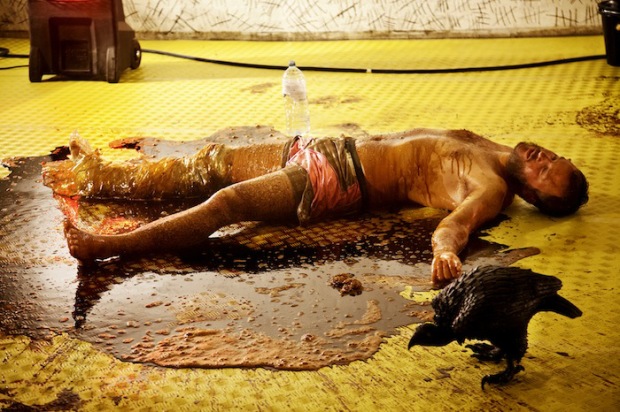You have no items in your cart. Want to get some nice things?
Go shopping
The myth of Philoctetes has had a long and chequered history. Philoctetes, you may remember, was said to have been left behind on the island of Lemnos by Odysseus as a result of the festering snake bite on his foot. He remained alone on the island for a decade, until Odysseus returned with young Neoptolemus – at the behest of a Trojan oracle – to bring Philoctetes and the magic bow he inherited from Heracles to win the Trojan War. Philoctetes refused, but the timely appearance of Heracles himself convinced him to join them; old enmities were overcome, and the war was eventually won.
Or so the Sophoclean tragedy goes. The remaining fragments of Euripides’ version tell the story a little differently, and a brief look at the myth’s adaptation through the centuries attests to its plasticity. André Gide keeps Philoctetes, bowless, on the island (don’t worry though – he will live. The final, spectacularly florid stage direction asks that “birds from heaven come down to feed him”). In Heiner Müller’s imagining, Philoctetes is stabbed in the back by Neoptolemus, while Stoppard reconfigures the myth in the colouring of a Le Carré-esque conspiracy. The story’s scope for adaptation is endless, and its most recent incarnation – at the Yard Theatre in Hackney – adds to this longstanding history of revisionism.
Lemnos is reconceived here as the interior of a converted warehouse. The liminality of the isolated desert island is echoed in the bizarre set – littered with rubber vultures and moveable stage lights – and perpetuated by the timelessness of this production. We are still in the middle of the Trojan War, but our heroes are dressed in head-to-toe Nike (a sportswear brand, yes, but also the name of the Greek goddess of victory), and their expletive-ridden language feels decidedly contemporary. The most notable feature of this production’s design, however, is its use of great pools of black-brown treacle, an attempt, director and writer Jeff James tells me, to depict the “excessive and crazy baroque nature of the rotting foot”. The treacle is everywhere; it seeps from Philoctetes’ leg and encompasses his body, smearing across the stage in thick and oozing slicks. There is a bathtub full of the stuff, and eventually Neoptolemus too gets coated with the sickly-sweet tarnish.
Donated by Tate & Lyle Sugars, the treacle is an inspired touch. The stink of the wound, so powerful as to have driven away Odysseus and his men when Philoctetes was first bitten, is replaced here with a far-reaching saccharine stench. The treacle inhibits the actors’ movement; it perpetuates the crippled Philoctetes’ state of slowness and constraint. And the syrupy mire it creates around the actors reflects the play’s central theme of uncertain moralities. “Hide not thy poison with such sugar’d words,” says Shakespeare’s Henry VI, and James plays effectively on this image of too-sweet deceit.
The physicality of the production sets it apart from its Attic ancestor. We see the pained struggle of Philoctetes as he moves around the island, while his state of uncleanliness is rendered in the mar of smeared treacle across his body. The eloquence of previous Philocteteses has always been a source of difficulty for me – he has, after all, been alone and unspeaking for ten long years. In this production, Daniel Millar fumbles with inchoate sounds for several minutes as he tries to find the “Greek” to speak with Neoptolemus. His psychological anguish is apparent also, as is the clear moral turmoil of young Neo, played with charming hesitation by Joshua Miles. In the reimagining of Odysseus as a redoubtable woman, James makes a marked move away from the play’s masculine heritage. Rosie Thomson is magnificent in the part, remorseless and pragmatic, switching on and arranging the stage lights as though orchestrating the play herself, a sly nod to the story’s theme of free will versus determinism.
This question of free will was, I felt, one of the messages I took away from the evening, along with the gentle interrogation of ethics (there is no clear morality in the tale and, as a result, none of the three central characters emerges as morally triumphant; “I don’t believe in heroes,” James admits. “And I don’t think the play does either”). But as I thought on the production on the train home, the messages began to be lost in the general, syrupy haze of action and set. Over the past couple of centuries, the figure of Philoctetes has frequently been employed as a political tool: Heaney draws on the story’s theme of self-accountability in an indirect commentary on the Irish Troubles. Müllerbegan his Philoktet a year after Stalin’s death, and it has been said to reflect the convalescence of the imprisoned members of the Communist Party who suffered at the hands of the East German Stalinist regime. Interestingly, the myth’s political dimension was even testified to within the walls of the Bastille; “Philoctète” was employed as the pen name of one Antoine Alleighe, imprisoned there in the eighteenth century (these examples and more can be read in Seth Schein’s comprehensive survey on the topic).
With these precursors in mind, I found it difficult to feel the weight of James’s timeless, locationless adaptation. If we searched, we might be able to find a comment here on British isolationism – hinted at in the lone figure of Philoctetes – but this was not made clear in the production; it was only afterwards that James confessed that he is “sceptical of one’s ability to intervene in the world”. But would an apolitical reading of the story be so very reprehensible? And is there any harm in the myth being staged as entertainment alone? For entertaining it unquestionably is. In a departure from Sophocles’ strict tragedy, James creates moments of laugh-out-loud humour. Philoctetes suffers from his festering foot, certainly – but he is also very funny, clinging to Neoptolemus, sullying him with treacle, interrupting his speech with unwanted eulogies.
What’s more, the players seem fully aware of their own fictionality. They skilfully move the set around as they speak, and Odysseus appears in a number of disguises – including that of the smoke-machine assisted, spandex wearing Heracles. ‘This isn’t how the story ends,’ we hear at the close, in acknowledgement of the play’s reworked finish; and, in as much, its reading as a playful spin on an age-old story is knowingly allowed. The production is clever, slick and entertaining. And if it lacks a thematic punch, it more than makes up for it in the sweetness of its imagery.
Stink Foot continues at the Yard Theatre until December 13. Tickets are £10-£12.50.

About Xenobe Purvis
Xenobe is a writer and a literary research assistant. Her work has appeared in the Telegraph, City AM, Asian Art Newspaper and So it Goes Magazine, and her first novel is represented by Peters Fraser & Dunlop. She and her sister curate an art and culture website with a Japanese focus: nomikomu.com.




